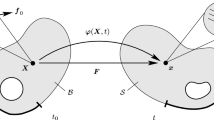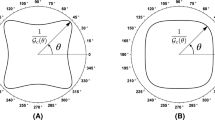Abstract
We present an adaptive phase-field method for modeling crack propagation in orthotropic composites. The numerical approach extends an adaptive phase-field formulation, originally developed for isotropic linear elastic materials, to general orthotropic materials. The method to evaluate the constitutive tensor for a general orthotropic material is first discussed. The modification of the phase-field equation to incorporate the effect of orthotropy on damage evolution is then described. Simple numerical patch tests are formulated and used to validate the developed orthotropic material model. The coupled numerical framework is then utilized to study the influence of fiber orientation, and mechanical properties of fibers and matrix on the failure processes in orthotropic composites. The numerical studies indicate that the macro-scale failure behavior of laminates is primarily influenced by the mechanical properties of the matrix. Furthermore, the macro-scale fracture toughness of laminates increases when the individual lamina’s transverse normal critical energy release rate is large in comparison with the critical energy release rate of the adhesive. In this configuration, partial delamination of the lamina interface is favored, and therefore, a progressive ductile failure of laminates is observed. This observation can be used to engineer laminates from a damage tolerance-based design perspective.












Similar content being viewed by others
References
Krueger, R.: Virtual crack closure technique: history, approach, and applications. Appl. Mech. Rev. 57(2), 109–143 (2004)
Rice, J.R.: A path independent integral and the approximate analysis of strain concentration by notches and cracks. J. Appl. Mech. 30(35), 379–386 (1968)
Yu, H., Kuna, M.: Interaction integral method for computation of crack parameters k–t-a review. Eng. Fract. Mech. 249, 107722 (2021)
Kim, H.-G.: Interface element method (IEM) for a partitioned system with non-matching interfaces. Comput. Methods Appl. Mech. Eng. 191(29–30), 3165–3194 (2002)
Cho, Y.-S., Jun, S., Im, S., Kim, H.-G.: An improved interface element with variable nodes for non-matching finite element meshes. Comput. Methods Appl. Mech. Eng. 194(27–29), 3022–3046 (2005)
Settgast, R.R., Fu, P., Walsh, S.D.C., White, J.A., Annavarapu, C., Ryerson, F.J.: A fully coupled method for massively parallel simulation of hydraulically driven fractures in 3-dimensions. Int. J. Numer. Anal. Meth. Geomech. 41(5), 627–653 (2017)
Duarte, C.A., Oden, J.T.: An HP adaptive method using clouds. Comput. Methods Appl. Mech. Eng. 139(1–4), 237–262 (1996)
Duarte, C.A., Babuška, I., Oden, J.T.: Generalized finite element methods for three-dimensional structural mechanics problems. Comput. Struct. 77(2), 215–232 (2000)
Moës, N., Dolbow, J., Belytschko, T.: A finite element method for crack growth without remeshing. Int. J. Numer. Meth. Eng. 46(1), 131–150 (1999)
Francfort, G.A., Marigo, J.-J.: Revisiting brittle fracture as an energy minimization problem. J. Mech. Phys. Solids 46(8), 1319–1342 (1998)
Bourdin, B., Francfort, G.A., Marigo, J.-J.: Numerical experiments in revisited brittle fracture. J. Mech. Phys. Solids 48(4), 797–826 (2000)
Miehe, C., Welschinger, F., Hofacker, M.: Thermodynamically consistent phase-field models of fracture: variational principles and multi-field Fe implementations. Int. J. Numer. Meth. Eng. 83(10), 1273–1311 (2010)
Miehe, C., Hofacker, M., Welschinger, F.: A phase field model for rate-independent crack propagation: Robust algorithmic implementation based on operator splits. Comput. Methods Appl. Mech. Eng. 199(45–48), 2765–2778 (2010)
Alessi, R., Freddi, F.: Phase-field modelling of failure in hybrid laminates. Compos. Struct. 181, 9–25 (2017)
Bleyer, J., Alessi, R.: Phase-field modeling of anisotropic brittle fracture including several damage mechanisms. Comput. Methods Appl. Mech. Eng. 336, 213–236 (2018)
Reinoso, J., Arteiro, A., Paggi, M., Camanho, P.: Strength prediction of notched thin ply laminates using finite fracture mechanics and the phase field approach. Compos. Sci. Technol. 150, 205–216 (2017)
Natarajan, S., Annabattula, R.K.: Modeling crack propagation in variable stiffness composite laminates using the phase field method. Compos. Struct. 209, 424–433 (2019)
Zhang, P., Hu, X., Bui, T.Q., Yao, W.: Phase field modeling of fracture in fiber reinforced composite laminate. Int. J. Mech. Sci. 161, 105008 (2019)
Denli, F.A., Gültekin, O., Holzapfel, G.A., Dal, H.: A phase-field model for fracture of unidirectional fiber-reinforced polymer matrix composites. Comput. Mech. 65(4), 1149–1166 (2020)
Gültekin, O., Dal, H., Holzapfel, G.A.: A phase-field approach to model fracture of arterial walls: theory and finite element analysis. Comput. Methods Appl. Mech. Eng. 312, 542–566 (2016)
Pranavi, D., Rajagopal, A., Reddy, J.: Interaction of anisotropic crack phase field with interface cohesive zone model for fiber reinforced composites. Compos. Struct. 270, 114038 (2021)
Muixí, A., Fernández-Méndez, S., Rodríguez-Ferran, A.: Adaptive refinement for phase-field models of brittle fracture based on Nitsche’s method. Comput. Mech. 66(1), 69–85 (2020)
Udhayaraman, R., Mulay, S.S.: Multi-scale approach based constitutive modelling of plain woven textile composites. Mech. Mater. 112, 172–192 (2017)
Gibson, R.F.: Principles of Composite Material Mechanics. CRC Press, Taylor and Francis group (2016)
Muixí, A.: Locally adaptive phase field models and transition to fracture. PhD thesis, Universitat Politécnica de Catalunya (2020)
Annavarapu, C., Hautefeuille, M., Dolbow, J.E.: A robust Nitsche’s formulation for interface problems. Comput. Methods Appl. Mech. Eng. 225–228, 44–54 (2012)
Annavarapu, C., Hautefeuille, M., Dolbow, J.E.: Stable imposition of stiff constraints in explicit dynamics for embedded finite element methods. Int. J. Numer. Meth. Eng. 92(2), 206–228 (2012)
Annavarapu, C.: An efficient finite element method for interface problems. PhD thesis, Duke University (2013)
Acknowledgements
The support from the Ministry of Education, Government of India, and IIT Madras to the first, second, and fourth authors is gratefully acknowledged under the Start-up Research Grant, SP21221642CESERB008957 and the Subsurface Mechanics and Geo-Energy Research Grant, SB20210856CEMHRD008957.
Author information
Authors and Affiliations
Corresponding author
Additional information
Publisher's Note
Springer Nature remains neutral with regard to jurisdictional claims in published maps and institutional affiliations.
Rights and permissions
Springer Nature or its licensor (e.g. a society or other partner) holds exclusive rights to this article under a publishing agreement with the author(s) or other rightsholder(s); author self-archiving of the accepted manuscript version of this article is solely governed by the terms of such publishing agreement and applicable law.
About this article
Cite this article
Jain, I., Annavarapu, C., Mulay, S.S. et al. Numerical modeling of fracture propagation in orthotropic composite materials using an adaptive phase-field method. Int J Adv Eng Sci Appl Math 15, 144–154 (2023). https://doi.org/10.1007/s12572-023-00331-w
Accepted:
Published:
Issue Date:
DOI: https://doi.org/10.1007/s12572-023-00331-w




